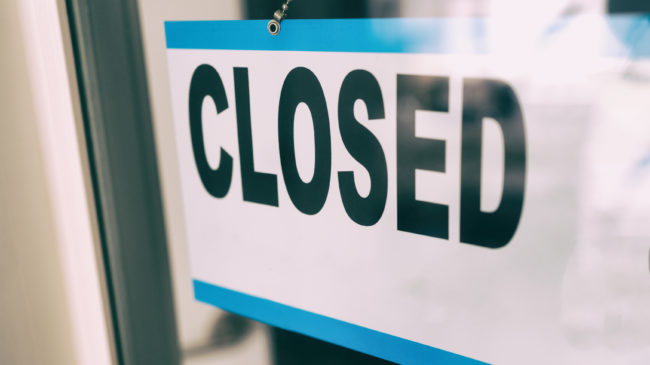Americans, policymakers and small businesses all face many difficult choices during the coronavirus outbreak. In the last two weeks, political leaders from both parties have largely responded to the COVID-19 pandemic by telling people to stay home and requiring many businesses to close, shutting down large swaths of the economy. “By the end of this weekend, nearly 9 in 10 Americans will be [under stay-at-home orders],” The Washington Post reports.
The most optimistic economists believe the economy will bounce back quickly once the public health crisis has passed. For example, last week, Nobel Prize-winning economist Vernon Smith wrote:
I believe the economy today lives in suspense, not free-fall. The pandemic will pass; public health institutions have been a model of forthright dissemination of information on the spread of this disease and sanitary procedures to minimize its impact. It’s the citizenry that has been unruly for a time. Supply chains will refill and stabilize quickly, as the pandemic passes, securities markets will recover, and growth will continue to reduce poverty everywhere. Homes are more valuable than ever as a haven of safe and secure living. Provided that we continue to buy them with some of our own money, homes will be part of a secure future.
Sadly, I take a different view. I agree that the American economy is not structurally broken, as of today, but it could be broken by the time large numbers of people are allowed to go back to work.
There are more than 30 million small businesses in America and nearly half of working Americans receive their income from a small business. As an accountant, I’ve advised and helped manage many small businesses over the years and I’m familiar with their typical cost structure and operating margins. The biggest problem for small businesses is, depending on how long the current near-nationwide shutdown of commerce continues, they may no longer be around once the majority of things re-open.
Most businesses face fixed costs. Even if they suspend all operations and furlough their employees, they still must pay rent, insurance expenses, equipment leases, and meet other contractual obligations. Few small businesses maintain the cash reserves sufficient to absorb these costs for an indefinite period without money coming in. In fact, corporate finance texts generally tell small businesses that it’s inefficient to hold onto cash that’s not earning a return, since the people who provide that cash—noteholders, equity investors, etc.—are all due a return for providing the cash. Therefore, businesses tend to use their available capital to invest in equipment, personnel, marketing or other expansion techniques to generate a return over and above their cost of capital. And, as a result, most small businesses, and even some large ones, will soon face cash squeezes that threaten their continued existence.
A wise small business might have contingency plans for a drop in revenue of 30 percent over a relatively short period of time. But very few businesses plan for a sudden, unexpected loss of most, if not all, their revenue for an indefinite period of time.
In this case, most businesses also generally can’t receive insurance payouts because the insurance industry as a whole created exclusions against business interruption policies for pandemics following the outbreak of SARS in 2003.
That means the longer the shelter-in-place shutdowns continue, the more businesses will fold. When workers are eventually told they’re allowed to return to work, many will find their jobs no longer exist. That scenario could create massive structural unemployment not just in the United States, but across the globe.
Yesterday we learned a record 6.6 million Americans filed for unemployment last week:
6.6 million US workers filed for their first week of unemployment benefits in the week ending March 28, according to the Department of Labor — a new historic high.
That was far greater than economists had expected, and more than 3,000% the pre-pandemic levels. Unemployment claims at this level suggest a severe job market decline hardly any American alive has ever seen in their lifetimes.
Economists characterized the increase as “monstrous,” “stunningly awful,” and “a portrait of disaster.”
Including the prior week’s 3.3 million initial claims, Americans have filed nearly 10 million jobless claims in the last two weeks alone.
James Bullard, president of the Federal Reserve Bank of St. Louis, recently forecasted as much as 30 percent unemployment once the stay-at-home orders and business shutdowns are over. That unemployment figure would be higher than the United States has ever seen, including during the worst of the Great Depression. The Federal Reserve can’t print enough money to pay the bills of every business.
Public health officials have been right to warn about the dangers of COVID-19, but there are also substantial dangers to this scale of potential economic downturn that are important to talk about as well. Contrary to the false dichotomy offered in some quarters, this debate isn’t about money versus human life.
It’s very plausible that the coronavirus pandemic could trigger a global depression. During a depression, everything is in short supply, including food and medical supplies needed to fight COVID-19. Historically, global depressions have also triggered widespread social unrest and even war.
As the country grapples with coronavirus, we should not ignore the public health dangers or economic dangers we’re confronting. The debate about the merits of a long-term, near-total economic shutdown should be framed in the context of which approach averts the greatest toll on human life. It is important to understand the mortality rate inflicted by the coronavirus, but it is also important to understand the full scope of consequences that policy decisions and their economic outcomes have on people’s lives and health.

